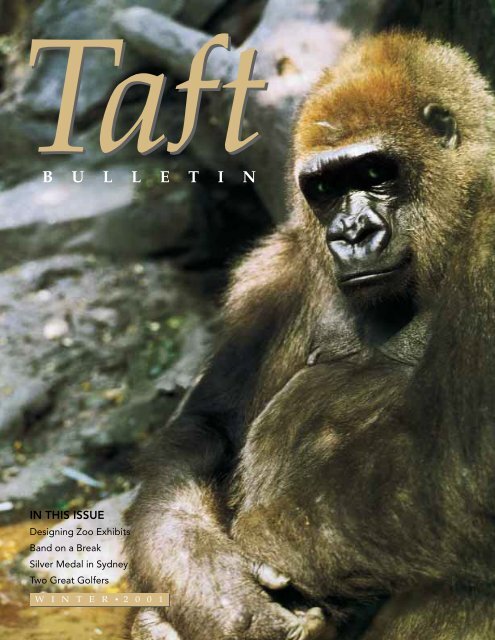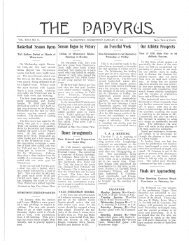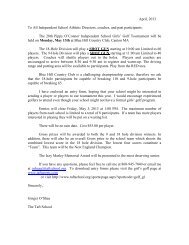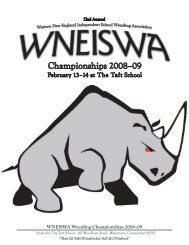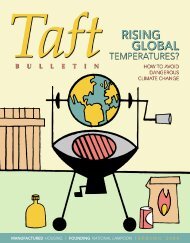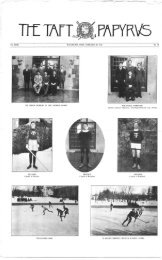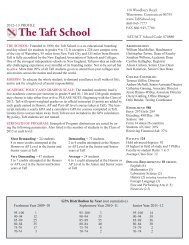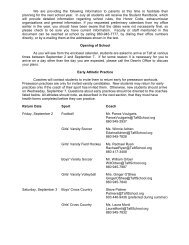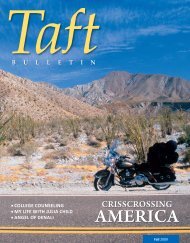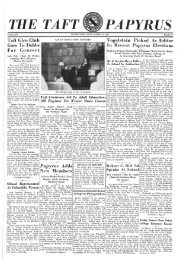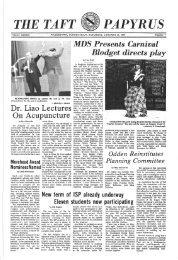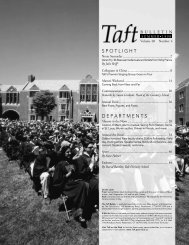IN THIS ISSUE - The Taft School
IN THIS ISSUE - The Taft School
IN THIS ISSUE - The Taft School
- No tags were found...
You also want an ePaper? Increase the reach of your titles
YUMPU automatically turns print PDFs into web optimized ePapers that Google loves.
AROUND THE PONDMonastic CreationTen Tibetan monks from the DrepungGomang Monastic University visited campusfor five days in the fall. From October30 to November 3, they worked daily onthe construction of a sand mandala in theMark W. Potter ’48 Gallery.<strong>The</strong> creation of a mandala (Sanskritfor circle), the traditional art form of TibetanBuddhism, is said to effectpurification and healing. <strong>The</strong> paintingthey chose to create at <strong>Taft</strong> is called themandala of compassion, the most sacredof all mandalas.“<strong>The</strong> response to their visit was overwhelming,”said Chaplain MichaelSpencer. “Through their powerful presencethey transformed this school in fiveshort days. <strong>The</strong>y shared their culture, theirreligion, their art, their music, and mostimportantly their lives with us in a completelyopen and honest manner. <strong>The</strong> kidsrespected and responded to this honesty.”While on campus, the monks visitedclasses to talk about their personal historiesand the history of Buddhism, and held<strong>The</strong>ir creation complete, the monks sweep up the mandala and pour the sand into Potter’sPond, symbolizing the impermanence of all existence.Monks spend six to eight hours a day workingon the mandala, using only narrowmetal funnels called chakpurs to layer millionsof grains of colored sand in thesetraditional patterns.special prayer sessions. Many visitors cameto the gallery to observe the mandala constructionas well as the prayers.“Every day I walked into the gallery,”Spencer said, “to find students sitting andwatching the monks construct the mandala,and every morning they attended morningchanting with the monks.”At the end of the week, the monksassembled to dismantle their work of art.Nearly 300 people packed the new artgallery to witness the ceremony, manyspilling out into the halls.“This was truly a magnificent event,”Spencer said. “<strong>The</strong> monks taught us apowerful lesson about life and deaththrough the art of the mandala: that allthings are impermanent, that what remainsis the memory of the beautiful,and that beauty is meant to be shared.”<strong>The</strong> monks are on a year-long tourof the U.S. to raise money to supporttheir monastery in India, where many Tibetans,including the Dalai Lama, havelived in exile since 1959.<strong>Taft</strong> Bulletin9
AROUND THE PONDListening to LeeDr. Henry C. Lee, a world renowned expertin the field of forensic evidence and criminalinvestigation, spoke at Morning Meetingon November 13. Dr. Lee has assisted lawenforcement agencies and investigated 6,000major cases around the world.A consultant for over 300 police andlaw enforcement agencies, he has servedForensics expert Dr. Henry Lee explains theinteresting twists in some of his high-profilecases to very live subject, head monitor TarikAsmerom ’01. Photo by Peter Frew ’75Blind AthleteInspires StudentsErik Weihenmayer, a skydiver, skier,long-distance biker, marathoner,wrestler, scuba diver, and mountainclimber internationally known for hisachievements as a blind athlete, spokeat Morning Meeting on October 5.Weihenmayer, who was totallyblind by age 13, first achieved prominenceas a championship high-schoolwrestler when Barbara Walters interviewedhim on ABC’s 20/20. Sincethat time, he has run, walked, andbicycled across several countries insupport of various causes. His mostnoted accomplishments, however, arein rock, ice, and mountain climbing,which he calls his “bliss.”This versatile 31-year-old athletehas scaled Mt. McKinley, Yosemite’sEl Capitan, Mt. Kilimanjaro, andas an expert witness in many high profileinvestigations and nationally andinternationally known cases for boththe prosecution and the defense. Hespoke with students and faculty abouthis many experiences, including theO.J. Simpson trialBorn in China in 1938, Lee isan author and editor, as well as anadjunct professor at eleven medicalschools and universities. He graduatedfrom the Taiwan Central PoliceCollege before working in the TaipeiPolice Department as a police captain.He came to the United Statesand received his BS degree in ForensicScience in 1972 from JohnJay College of Criminal Justice inNew York. Continuing his studiesat New York University, Lee earnedhis Ph.D. in Biochemistry in 1975.Source: Laurie Lambert, <strong>Taft</strong> Press ClubAconcagua (the tallest peak in SouthAmerica). In fact, Weihenmayer isslated to become the youngest person—blindor sighted—ever to scaleall “Seven Summits,” the highestmountains of all seven continents.In his talk, Weihenmayer emphasizedthe ability to shatter expectations,telling students, “Someone once toldme I needed to recognize my limitations,but I find it much more fun totry to realize my potential.”We can elevate ourselves andthose around us by acting with bothpassion and dedication, he said.“Imagine everyone connected by agiant rope, helping each other, compensatingfor individual weaknesses,using everyone’s abilities to the fullest.We’d be an unstoppable force.”Serving<strong>The</strong> school’s annual Community Service Dayhas grown since its inception five years ago.Now encompassing on-campus workshops for120 area schoolchildren as well as off-campusprograms, the day provides all <strong>Taft</strong>students with an opportunity to reach out intothe greater community.<strong>The</strong> logistics for such an event are nothingshort of those for a full-scale invasion. Buses,cars, vans, and footpower propelled students toWoodbury, Waterbury, Danbury, Bethlehem,and other area towns. Students and facultypitched in at theaters, cemeteries, nature centers,hiking trails, abandoned city lots, schools,convalescent homes, museums, libraries, seniorcenters, child care centers, churches, shelters,and helped such groups as the Nature Conservancy,YMCA, and the Red Cross.Whether it was spent painting, raking,cleaning, or just visiting with people, CommunityService Day continues to be one daywhen students can step out of their everydaylives and make a difference.“While Community Service Day is the mostvisible time during the year,” said Chaplain MichaelSpencer, who orchestrated the day, “it is importantto remember that we strive to translate the words ofour motto—not to be served but to serve—intoaction every day through the Volunteer Program.”Peter Granquist ’03 helps landscape an abandonedlot in Waterbury.10 Winter 2001
AROUND THE PONDthe CommunityStudents clear brush and help with landscaping at a local veterans’ cemetery.Nadia Zahran ’03, right, helps a middleschool student in the printmaking studioduring one of the on-campus workshops.Senior Art students brighten up a hallway atHeminway Park <strong>School</strong>.Wan Ling Yih ’04, Patsy Odden, and Katie Stratton ’01, plant spring bulbs betweenthe town hall and local library.<strong>Taft</strong> Bulletin11
AROUND THE PONDPaduano SpeakersDr. Christina Sommers spoke on “moraleducation and misinformation” at MorningMeeting on October 19. She is theauthor of <strong>The</strong> War Against Boys: How MisguidedFeminism Is Harming Our YoungMen and Who Stole Feminism? HowWomen Have Betrayed Women.An outspoken critic and keen philosopher,Sommers has appeared on Nightline,ABC Evening News, CBS Evening News,Crossfire, 20/20, Inside Politics, the OprahWinfrey Show, and Eye to Eye to discuss suchissues as the future of feminism and genderbias in schools. Sommers is the W. H. BradyFellow at the American Enterprise Institute,and professor of philosophy at Clark Universitysince 1980. Her talk provided aninteresting foil to the opening faculty addressby Eli Newberger, author of Boys andthe Men <strong>The</strong>y Will Become, in September.Sommers is the first speaker to come to<strong>Taft</strong> through the generosity of the newly en-dowed Paduano Lecture Series in Philosophyand Ethics. Created by the parents ofJohn Paduano ’99, the series is co-sponsoredby the Philosophy, Religion, and Ethics Departmentand the Spiritual Life Committee.Professor Peter Kreeft, a philosophy professorfrom Boston College, was scheduled tospeak in January about “the dangers ofmoral relativism.”<strong>The</strong> Paduano series also helped fund thevisit of the Tibetan monks in November (page 7).Private ScreeningAlan Klingenstein ’72, producer of theSundance Audience Award winningfilm, Two Family House (Alumni in theNews, fall 2000), arranged a privatescreening of his newest release in <strong>Taft</strong>’sBingham Auditorium. DirectorRaymond DeFelitta and Klingensteinintroduced the film and stayed afterwardto talk with faculty and students.Praising the Benefits of a Liberal EducationBrendan Fitzgerald ’82, vice president forinternational production at ColumbiaTristar Pictures, has traveled extensivelyand offered his insights on the televisionindustry worldwide. In his November 7visit, Fitzgerald stressed the importanceof a liberal education and spoke aboutthe many ways he has used not only hisknowledge of foreign languages but ofhistory and science as well.Fitzgerald spoke eloquently aboutthe challenges in producing a televisionshow in one country that has its roots inan entirely different culture. He visitedacting and film classes, and spoke withstudents at sit-down dinner, he also hostedan open forum discussion in the ISPLiving Room immediately after dinner.Current Parents’Committee Meet inNew York CityMore than 50 current parents joined Patsyand Lance Odden at <strong>The</strong> Sky Club onWednesday, September 20, for a dinnerhosted by new Parents’ Fund chairmen Caroland Will Browne P’98,’01.Louise Gallagher P’02,’03 and HeadmasterLance Odden P’86,’89Nancy and Woody Ladd P’99,’01 with AnneAdler P’97,’99,’01, centerJoe and Peggy Toce P’98,’01, Julie and MikeFreeman P’03, Rosemarie and Scott ReardonP’98,’01,’03, and Gail Berardino P’01Jim Little P’03, Lisa Ireland P’02, and WillBrowne P’98,’01Barbara and Henry Gooss P’02 with PatsyOdden P’86,’89, center12 Winter 2001
NEW HEADMASTERMacMullen Named FirstAlumni HeadmasterOver the years <strong>Taft</strong> has produced many fineheadmasters from its alumni and facultybodies, but for the first time in the school’shistory a <strong>Taft</strong> alumnus has been named tolead his alma mater: William R.MacMullen ’78.At a special meeting of students andfaculty, Board Chairman John L.Vogelstein ’52 announced Willy’s unanimousselection by the board of trustees.“Willy MacMullen brings remarkableexperience, energy and vision, and a deepcommitment to the school’s belief in educatingthe whole person,” John said. “He is incredibly well qualifiedto lead <strong>Taft</strong> as the school enters a new era, and he will surely do so ina distinctively creative and inspirational fashion.”Soon to be the school’s fifth headmaster, Willy emergedas the board’s unanimous choice following an extensive searchlaunched in September. Search Committee Chairman John W.Dayton ’64 characterized the process as wide-ranging and involvinga multitude of voices.“Our committee was impressed by the exceptional depthand breadth of the pool of candidates,” John said. “While wefound the task of narrowing the field difficult, we were able todraw on the tremendous involvement of students and faculty inthe process and the broad participation and counsel of countlessalumni and parents. Without this strong base of support andthe guidance of an advisory committee consisting of students,faculty, alumni, and parents, our task would have been evenmore difficult. Again and again, I found myself marveling athow truly fortunate the school is to have such diverse andthoughtful support and interest.”“Willy has always been someone the school could turn tofor leadership,” said fellow English teacher Steve Palmer. “Heis incredibly dedicated and highly versatile.”A member of the faculty for 18 years, Willy returned to<strong>Taft</strong> in the fall of 1983, having graduated from Yale Universityand having spent a year teaching “disadvantaged” boys at thePike <strong>School</strong> in New Hampshire. While at <strong>Taft</strong> he has distinguishedhimself as a class dean, English teacher, co-founderand director of the Senior Seminar program, and varsity soccercoach. He has served as dean of academic affairs, dean offaculty, director of teaching fellowships, and assistant directorHeadmaster-designate Willy MacMullen ’78 withhis wife, Pam, and sons Tom and Johnof college counseling. He earned hismaster’s degree at Middlebury College in1989 and was named the Edwin C. DouglasChair in 1998.“Willy is uniquely qualified, “saidHolly McNeill, a member of the facultyadvisory committee, “because of his commitment,energy, devotion, andenthusiasm—he is truly passionate aboutthe opportunity to take <strong>Taft</strong> to the nextlevel. He has a real vision for what thisplace can be and loves this school the wayLance has.”“Students who know Mr. Mac see an intensity about him,”said Papyrus editor Andrew Karas ’01, “and even those whodon’t have direct contact with him respect him for his clear,distinct presence here, and so we welcome the trustees’ decision.Beyond intelligence and eloquence,” he added, “Mr. Machas a kind of grace and vision that will allow him to sustainwhat has made <strong>Taft</strong> wonderful during my time here.”Clearly moved by his appointment, Willy briefly addressedthe assembled school community after John Vogelstein’s announcement,saying, “I learned from my own parents’ examplethat there is no more noble vocation than teaching. I am gratefulthat I have been able to teach at a school for 18 years under aleader who has been an inspiration and more than a headmaster.“I am grateful that I get to teach with my best friend—I get togo to school everyday with my wife,” Willy said. “Not many peopleget to do that. I am deeply grateful for the scores of students—pastand present—who fill me like a cup overflowing, and for my colleagueswho inspire me everyday. It is the students and the teachers,finally, who make this school what it is.”Headmaster Lance Odden, who retires in June after leading theschool for 29 years, has welcomed his successor by saying, “I amthrilled by the selection of Willy MacMullen. He has a wonderfulway with people, knows secondary schools well, and is deeply devotedto young people. His energy, intellect, and vision assure that<strong>Taft</strong> will continue its historic role as one of the nation’s leading schools.”Willy’s wife Pam, who also earned a master’s degree atMiddlebury College, teaches English at <strong>Taft</strong> and serves as directorof public relations. <strong>The</strong>y have two sons, John, 5, andTom, 3. An interview with the MacMullens will run in thesummer issue of the Bulletin.<strong>Taft</strong> Bulletin13
ZooStories
S P O T L I G H TInvolving Visitors in Wildlife ConservationBy Julie ReiffZoos have come a long way since I was a child. I can still remember the firsttiger I ever saw—a big, beautiful, and angry animal pacing along the barsof his cage, his enormous paws landing silently on the flat concrete floor.<strong>The</strong> prison-like setting with its foul odor did nothing to diminish the regalbearing of this giant cat; it only highlighted the injustice.Contrast this with the Bronx Zoo, one of the world’s most renownedresources for animal conservation, where animals are the ambassadors of theirspecies, educating us, moving us, and forcing us to rethink our priorities.And the premier exhibit at this zoois Congo Gorilla Forest, created by JohnGwynne ’67, vice president and chiefcreative officer with the Wildlife ConservationSociety, the group that operates theWildlife Centers of Central Park and ProspectPark in Queens, the New YorkAquarium, the Bronx Zoo, and now theWildlife Survival Center on St. Catherine’sIsland, Ga. Congo is the largest exhibit everundertaken by WCS, so far.“Congo” is designed to “provide anew model for integrating a zoo exhibitof living creatures with a call to conservationaction.”“We [WCS] have the largest team offield scientists in the world out there study-ing those animals, counting them, tryingto get a sense of how much land they needto survive,” John says. “Roughly four anda half million people visit our five institutionsin New York; that’s about 2 percentof all Americans, or really 1.5 percent sincemany people come more than once. Howdo we take these great parks—with theirgreat animals and important breeding programs,”John asks, “and use the visitor’sexperience to inspire other people to careabout conservation?”<strong>The</strong> answer spawned a series of newkinds of exhibits, of which Congo is(LEFT) John’s responsibilities includedesigning exhibits at the Bronx Zoo andfour other Wildlife Conservation Societycenters. (RIGHT) Like actors in a play, thegorillas need a good stage, so John and hisstaff found ways to design the exhibit tolure the animals where visitors can best seethem. Photographs by Jessica Wynne ‘90<strong>Taft</strong> Bulletin 15
S P O T L I G H Tprobably the most important, and inmany ways the first of its kind. “It’s abig exhibit,” Johns says. “We’ve addedthousands and thousands of plants;many of them we had to custom growourselves to give a feeling of being in atropical forest.“We’re trying to immerse you in a rainforest, to get you right up close and see themost wonderful creatures on our planet.This is very much a reaching out to helpsave wild places. We think of every one ofthese animals suddenly, not just as ambassadors,but as development directors tryingto seduce millions of people.”Already over a million visitors have beento the Congo, and what WCS has learnedin exit polls is that people who had no interestin conservation previously, suddenlyhave about a 55 percent jump in interestlevel, which, John adds, “is a very, very excitingthing.“We want to inspire people to careabout nature, by seducing them with howbeautiful a rain forest is. <strong>The</strong> best way todo that would be to take that millionpeople to central Africa.” But, since that’simpractical, there’s Congo.Set Design“We’re trying to tell stories,” John explains,“trying to make it a nature walk.We want people to think of it as differentfrom a zoo exhibit. Most traditionalzoos put animals in a space designed primarilyfor the viewer, a man-made space.We’re trying to flip that around and haveyou visit an animal’s natural space.”“And so we try to make it naturaland soft, but we also have to accommodatethousands of visitors.” Johnpoints to the path and says, “If this werereal mud it would be soupy and itwould run off into the moats andwould screw up our recirculating systemand all sorts of things. So we havedesigner mud. We copy it in concrete;otherwise we wouldn’t be able to keep“We’re trying to tellstories,” John explains,“trying to make it anature walk. We wantpeople to think of it asdifferent from a zooexhibit. Most traditionalzoos put animals in aspace designed primarilyfor the viewer, a manmadespace. We’retrying to flip that aroundand have you visit ananimal’s natural space.”these impressions of okapi and otheranimals in the walkway. All these rocksare sculpted. We don’t want you toknow that there can be as many as1,000 people at a time on this thirdof-a-mile-longtrail. We want people tofeel a personal experience in the forest,minimizing views of the people.”In fact, it’s hard to believe thatNew York City is just on the other sideof the hill. “One of the reasons we’rehere,” John says, “is so we can reachlarge numbers of people.”Cast MembersJohn points to an artisticallyrecreated weaverbird’s nest anda green mamba snake, putnearby to teach visitors thatgreen mambas tend to raid thosenests. “<strong>The</strong>y wait just like that,motionless. AndGoliath frogs (hepoints to one inthe shoulderhighstream thattrickles down the rocks onthe side of the trail) will sit in onespot week after week waiting for goodies—theworld’s largest frog. We madereplicas of certain animals to tell those stories,but we’re trying to make it subtle.”But how can one tell a jungle storyin the northeast corner of the U.S.?“We had to plant and maintain acertain kind of garden. Our horticulturecrews are carefully trained to prunegently so that it doesn’t look likechicken croquettes but like a jungle.Ninety-four percent of our visitors tothis part of the exhibit come in warmweather. We looked at the problem anddecided if we tried to do the whole sixand a half acres indoors, a) we’d neverbe able to afford the heat bills and b)we couldn’t afford to build the building.So we said we’re going to do itprimarily as a summer exhibit.”We pass the red river hogs when Johnsays, “Oh look, there’s a DeBrazza monkey;we’ve got two family groups here.”He stops to point out Wolf’s monkeys,“Isn’t that a beautiful animal,” he says.“<strong>The</strong>y’re closely related to DeBrazzas;both are very poorly known in nature.“In the past, zoos were consumersof wildlife, and right now as you cansee (he points out a new baby) we’re producers.One of the challenges is tomaintain healthy, genetically sound16 Winter 2001
Jessica Wynne ’90S P O T L I G H Tpopulations, in which everybody is notrelated to everyone else. It means we cooperatewith other zoos around theworld in communal breeding programs.Ninety-nine percent of mammals inAmerican zoos were born in Americanzoos. We don’t want to take animalsfrom the wild, and we don’t need to.”About the AuthorAlthough John trained as a landscape architectand first worked as the head ofEGAD (exhibition and graphic arts department),he clearly has extensiveknowledge about each of the animals inthe exhibit.“We’re sort of a catalyst,” he explains.“We work with the fieldscientists; we work with curators. Andwe ask them, ‘Where would you find aDeBrazza monkey?’ And they tell us thatthey’re always found along small, meanderingwatercourses. <strong>The</strong>y have tinyhome ranges and totally memorize everysquare inch. We ask what red riverhogs want and what mandrills need. Wehave to become specialists as well. Wehave to show these stories.“Personally I’ve always been interestedin the marriage of aesthetics andscience,” John explains. “One of thethings about nature is that every bit of itis so beautiful. That’s why I became alandscape architect.”John has also always had an interestin zoos. He grew up in Rhode Island andsaw some preliminary plans for the RogerWilliams Zoo in the local paper. “<strong>The</strong>ywere done by a well-intentioned localplanner,” he says, “but I thought theycould do something much better.” WhenJohn told the director his ideas, he woundup with a job.In 1982 the Bronx Zoo sought himout. John’s first job at WCS was to designthe Jungle World exhibit in “Asia,”and he’s been there ever since.John tells how a psychology professorcame up to him last year at the nationalZoo and Aquarium Conventionand told him that Jungle Worldchanged his life. “I thought it was alittle much,” John shrugs, “but hesaid he was so uplifted by it.”Comedy orTragedyThat’s one of the questions conservationists,as educators, are asking as theyprepare to tell their stories: Is it better toinspire visitors or worry them about conservationneeds?“If we have a huge audience thatwe’re inspiring about animals,” John asks,“how do we turn them into conservationists?What do we give them? Upbeatinformation—everything is hunky-dory,the world is wonderful? Or problem storiesabout great need?“We do believe that going to a zooshould be inspiring, but we think it’s unrealisticto totally whitewash the picture.So we carefully design exhibits in muchthe way you would read a novel or see anopera or a play. <strong>The</strong>re is a carefully choreographedstoryline.“We’re trying to grab people’s hearts.<strong>The</strong> exhibit was designed as a tunnel of inslopingglass so the gorillas are always inthe superior position.... “You are literallylooking up to a gorilla in every sense ofthe word,” John says.We lookfor ways to getpeople involved, to combine acognitive and an affective message insome logical way. <strong>The</strong> affective—the visceral,how you feel—is one of the keyelements of decision making, it’s howpeople decide what clothes to buy or whothey vote for in elections and so on.“<strong>The</strong> experience has to be beefed upby cognitive information as well; it isn’toften the primary decision-making factor,but it’s important for justifying orsupporting that affective decision. That’show advertising works. Madison Avenueis built on those principles, selling sizzle,not the steak.“We’re trying to figure out how toget people hooked: How to make conservationimportant to them, how tomake it relevant, how to make it somethingthat they understand on manylevels, viscerally as well as intellectually.”<strong>The</strong> Plot“In the first act, we set out to let you explorea rain forest first hand. You start tosee the animals in context: colobus monkeysand beautiful okapis (forest relativesof giraffes) sort of gliding through thetrees. You come around a corner and startto analyze what you just saw, using educationalconsoles, in an interactiveway—learning what mandrills eat, howthey use the forest.“Increasingly we’re making it moreinteractive, getting you involved in thinkingabout what you’re seeing, probingfurther. What is it? How does it fit intoecosystems, where does it nest?”<strong>Taft</strong> Bulletin 17
S P O T L I G H T<strong>The</strong>re are telescopes and things totouch—tactile objects like clipboards toflip through, small bronze sculptures oflizards or frogs, African art on the doorhandles—and a cross section of a hollowtree to see what’s happening inside. Johnand his team create all of these props tohelp tell this conservation story.“This is all trying to get you to explorea little further,” says John. “Sothen—after you start to explore the forest—wepresent you with a threat.Suddenly what you just started to loveis in trouble and one of the reasons it’sin trouble is because loggers are creatingroads for inner-forest access.Commercial hunters, followed by wavesof new populations, take those roadsdeeper and deeper into the forest, cuttingand turning it into agriculturalland. And that population is growing.It’s very, very real.”Next, the exhibit leads you into asmall theater. On the screen is a movieabout gorillas and their neighbors in theAfrican rain forest to show you it’s nottoo late to save important forests. “I’veseen people in tears,” John says “eventhose who don’t speak any English.”When the movie ends, the curtainspart and visitors are introduced to thestars: the whole gorilla gang, in theirrecreated jungle habitat.BackstageLike actors in a play, the gorillas need agood stage, so John and his staff foundways to design the exhibit to lure theanimals where visitors can best see them.“<strong>The</strong>re are heat coils built into thistree,” John points out. “We looked intocooling systems using ambient water, butwound up using a simple secondhand airconditioner so that on a hot day in thesummer, inside this tree is just a little bitcooler than elsewhere.”He points out the special technologyglass that shows no reflection. “Why“So when we began todesign Congo, we said,let’s figure out if there’ssomething we can doto empower the visitorto actually effect thereal African rainforest. That’s why wethink of the exhibit’sgorillas, monitors,fishes, and mice andall these wonders ofthe forest really asambassadors.”Madison Avenue doesn’t have it I don’t know,but maybe they’ll ask us about it.”<strong>The</strong> exhibit was designed as a tunnelof in-sloping glass, he explains, so the gorillasare always in the superior positionand we’re in the inferior. “You are literallylooking up to a gorilla in every sense ofthe word,” he says. “Because we’re in theinferior, the gorillas feel very comfortable.”So relaxed in fact, that a largesilverback male is leaning against theglass in front of me, snoozing. Hescratches himself in some indelicateplaces and shifts a little to get more comfortable.A female named Julia sees akeeper about to call them for dinner andcomes down too. She looks right at mewith beautiful dark eyes, and I am profoundlymoved.AudienceParticipationAt the end of the exhibit we arrive at theConservation Choices pavilion.“One of the innovations of thisexhibit is that visitors pay $3 before theygo in, and every cent of that goes directlyto central African conservation. It isn’tgoing into someone like Mobutu’s pocketbecause WCS is at that end, too, makingsure that it’s being spent properly. We letevery visitor get involved. Do they wantto help save gorillas, mandrills, okapis,or forest elephants? <strong>The</strong>y decide at thesetouch screens.“<strong>The</strong>n we put another layer on topof that,” he adds. “Conservation has threearms. One is discovering what an animalneeds, how many are there, what kind ofspace do they need, topography and soon. Second is involving local people. Itcan’t be done without local initiatives atevery level. <strong>The</strong> third is setting up protectedareas and working with the locallegislature. And if you want to help savemandrills you get to choose which ofthese three to fund.”John waits to see which I choose? Buthow does one pick? Having just fallen inlove with the gorillas, but not wantingthe other cast members to be upstagedby the stars, I agonize over the decision.“That’s one of the things we foundin our testing, that people do anguishover it,” he says. “But we want them to,because that’s part of the story; therenever are enough funds. We want theprocess to be real. Visitors are very excitedby this because they see that theyas individuals make a difference. We wantpeople to feel empowered and effective.”I make my choice and then hear the synthesizedsound of a flipping coin: ka-ching.I ask John what the biggest differenceis between Congo and Jungle World,his first project here.“<strong>The</strong> real change was involvingpeople,” he says. “We realized that we18 Winter 2001
S P O T L I G H Tgot people all excited about Asian rainforests, but we didn’t really involvethem. In 1995, we had a forest countdownclock and we showed how forestsdecline as the human population climbs,to more than six billion now. It’s athoughtful statement, but then peopleget on the monorail and they leave.“We are helping save rain forests,but we didn’t make that connection forvisitors. So when we began to designCongo, we said, let’s figure out if there’ssomething we can do to empower thevisitor to actually effect the real Africanrain forest. That’s why we think ofthe exhibit’s gorillas, monitors, fishes,and mice and all these wonders of theforest really as ambassadors.”Stage Crew“We have the greatest crews in the world—fabricators, curators, keepers, and so on. Thisis a fantastic organization and everyone carestremendously, and we all feel very missiondrivento try and inspire our visitors to give adamn. I have a particularly fantastic staff,” Johnadmits. “I’ve tried to find graphic designers,landscape architects, industrial designers, or programmers—peoplewho know how to seducepeople with field science, how to tell stories.“Increasingly our job has to be howto show a story. If what visitors see andwhat they read are not in perfect sync,then people who are coming throughwho are busy and don’t have a lot of timedon’t get the message. Almost everythingwe write or say in a film orvideo has to almost be a captionof what they’re looking at.”Coming AttractionsSo what is the sequel to the Congo Gorillastory, I ask? And what will they dodifferently this time?<strong>The</strong> answer is Tigers.“Tigers are very different from gorillas,”John explains. “Gorillas areextroverts. <strong>The</strong>y live in big familygroups. Tigers tend to be solitary, sortof like the difference between dogs andcats. Dogs probably never have enoughpatting and playing, but a cat is aloof.<strong>The</strong>y want you to know that they arecalling the shots. Tigers are like that.“One of the things we’re exploringnow is a way to showcase tigers in action.We’re looking at some giant catnipmice, something that may look like awild boar, something soft and grabbableand tear-up-able. This is a way to stretchtheir legs and provide stimulus for them.It also provides a way to show the spectacleof a huge tiger roaring across ameadow to pounce on something.“<strong>The</strong>re are only 300 Siberian tigersleft in nature,” John says. “Bengals are inthe best shape, Bali tigers are extinct,Sumatran tigers teeter now, and theCaspian tiger was wiped out in the 20 thcentury. One of the things that this organizationdoes is help save them. It’s nottoo late, but we all need to help.”We don’t yet know if tigers will livehappily ever after, but at the Bronx Zoo,John is preparing to tell their story.For more information about the WildlifeConservation Society or the Congo GorillaForest, visit www.congogorillaforest.com orwww.wcs.org.Bessie<strong>The</strong> rhino may seem new to many alumni,but it has been the school mascot sincethe late 1980s when I began work at <strong>Taft</strong>,so understandably I notice them everywhere.In addition to the live ones at thezoo, I asked John about a pair of statues Iobserved near the center of the park—bothnamed Bessie.Bessie was a great Indian rhino wholived at the Bronx Zoo for nearly 40 years.In the late ’30s Harvard University asked ifthe renowned sculptor Katherine Weemscould use Bessie as the model for two statuesto grace the entrance to their newbiology building. She went to the zoo andsculpted Bessie, twice—left and right.“I always admired those sculptures inCambridge when I was in graduate schoolthere,” John says. “When we were aboutto renovate the Zoo Center—one of theoriginal buildings in the park—we learnedof the story in our research. We said, ‘We’vegot to see if we could get some rhinos,too.’” <strong>The</strong>y contacted the artist, by thenin her 90s, who loved the zoo and gavethem the molds to make a second casting,provided they used a reputable foundry.<strong>The</strong> price they received was fairlydaunting, said John, but they decided toapproach Mrs. Astor, another generous supporterof the zoo, who said, “Okay, let’s doit. Let’s bring Bessie back from college.”—JSR<strong>Taft</strong> Bulletin 19
Trey Anastasio ’83, shown performingwith Phish last fall in Las Vegas,is using his time off tour to composeand arrange music for theVermont Youth Orchestra.©Reuters NewMedia Inc./CORBIS
S P O T L I G H TPHISH InsistIt’s a Break,Not a BreakupTrey Anastasio ’83 and fellow band memberstake time to reassess prioritiesBy Steve Morse, Boston Globe<strong>The</strong> sun goes up in the morning andgoes down at night. <strong>The</strong> rock ’n’ rollequivalent has been the VermontbasedPhish, touring with almost thesame regularity. So that’s why it wassuch a shock when the group announcedit was “taking a break” nowthat its latest tour has ended.<strong>The</strong> media went into spasms tryingto figure out what was going on. Wasthere friction in the band, as happenedto the Grateful Dead after Jerry Garciadied? What forces could be at work?Relax. Phish is not going away forgood. <strong>The</strong> upshot is that there’s a crucialdifference between “taking abreak” and “breaking up,” as someoutlets perceived it. To clarify matters:Phish is on hiatus for the next year,but please don’t talk about any “re-union” tours after that, because that’snot how the band views it.“It’s been astonishing to me howmany press outlets have turned this intoa case of ‘<strong>The</strong> band is breaking up andwho knows if they will ever play again.’Trey, guitarist and singer with the rock band Phish, at home in Vermont with his daughterEliza Jean in 1995. ©Nubar Alexanian/CORBIS<strong>Taft</strong> Bulletin 21
S P O T L I G H T<strong>The</strong>y’re just taking a break,” managerJohn Paluska says from the group’sBurlington, Vt., office. “We just simplydon’t know how long the break isgoing to be. That’s what has everybodyall up in arms.“But really, this is much ado aboutnothing. OK, it’s a story in that it’sbeen so long that [Phish] has been ona track, and to take an open-endedbreak represents a significant juncturein their career. And also to do it atsuch a peak of popularity when theycould so clearly continue to capitalizeon the momentum that’s happeningnow. A lot of people consider it to bea risky move, but it seems to me to bethe right move if you want to have along career. You don’t want to wear outyour welcome and then step aside andhope to restart it later.“We’re just going to disappear for awhile and not tour for probably at least ayear,” Paluska says of the group, whichstarted in the mid-’80s in Vermont. “We’vebeen pounding away for a long time. Oneof the nice things about this is that the[band members] can hopefully cycle downenough to reassess their priorities as musiciansand figure out what the most healthyapproach to the next phase of Phish is.“And that’s the approach that everyonehas—to take a few months apart,then hopefully they’ll be inspired to getback together and spend a bunch of timewithout any tour or album loomingoverhead. Just take time to write music,sort of the way they did 15 years agowhen they were just college students andhad occasional gigs, but didn’t have anyonepaying attention to them. <strong>The</strong>y justsat around and wrote music all the time.That’s a dynamic they’re interested inrediscovering and seeing where thattakes them creatively.”<strong>The</strong> band members—TreyAnastasio, Mike Gordon, Jon Fishman,and Page McConnell—will spend timewith their families. Anastasio, with twodaughters, and McConnell, with one, arethe only ones with children at this point.Reelin’ in the YearsBy Rob Brunner12/31/99Phish fans flock to the swampyFlorida Everglades for a marathonmidnight-to-dawn set tomark the new millennium.7/21/99When worlds collide: <strong>The</strong>band covers Pavement’s “GoldSoundz” at a concert outsidePittsburgh. Who says hippiesdon’t have good taste?3/18/97At a benefit for LakeChamplain, Ben and Jerry—yep, the ice-cream dudes—joinPhish on stage at Burlington’sFlynn <strong>The</strong>ater to celebrate thedebut of Phish Food, a chocolatemarshmallow concoctionstocked with little fudge fish.11/2/96<strong>The</strong> mainstream beckons: BillyBreathes debuts in Billboard’stop 10, smack-dab betweenNo Doubt and LeAnn Rimes.8/17/96In the wee hours, the four guysin Phish climb aboard a flatbedtruck and ride around serenadinga tent city of more than70,000 sleepy phans in upstateNew York at the Clifford Ball,the first summer camp-out show.12/30/94We’ll take Manhattan: Phishplay their first concert at NewYork’s Madison Square Garden.It sells out four hoursafter tickets go on sale.10/31/94A Halloween tradition is bornwhen the band performs itsfirst “musical costume”—theBeatles’ entire White Album.Since then, Phish have alsodressed up as <strong>The</strong> Who’sQuadrophenia, Talking Heads’Remain in the Light, and theVelvet Underground’s Loaded.5/7/94At a Dallas club, the band unleashesa nearly 70-minuteversion of “Tweezer,” somehowtouching on Aerosmith’s“Sweet Emotion,” the Breeders’“Cannonball,” and Prince’sIllustrations by Ward Sutton22 Winter 2001
S P O T L I G H TAnd Anastasio is the only member withconcrete musical plans: He is composingand arranging music for the VermontYouth Orchestra, and performed withthem at the Troy (N.Y.) Savings BankMusic Hall and the Flynn <strong>The</strong>atre inBurlington earlier this month.“Trey is actually melding a couple ofpieces into one bigger, orchestral piece,” saidPaluska. “He’s doing all the orchestral arrangements,which is a huge challenge forhim, and he’s very excited about it.”Gordon is finalizing details to releasea DVD of his film, “Outside Out,” anexperimental work about a high schoolstudent whose strict father wants him togo to military school rather than be a musician.<strong>The</strong> student is played by theeccentric Bruce Hampton, bandleader ofthe Aquarium Rescue Unit.None of the Phish members wasavailable to talk (“they’re in hibernation,”Paluska said) and it’s not known whatFishman and McConnell will do withtheir time off. But Phish fans need notworry in the meantime. <strong>The</strong> band membersare still getting along well, so this isfar from a permanent move.“I don’t want people to think thatthe band has broken up, and then a yearfrom now they come back and everyoneis like, ‘Oh, we thought you guysbroke up.’ That’s not it at all,” saysPaluska. “<strong>The</strong> band is just doing this tospend time with their families and rechargetheir batteries.”Republished with permission of Boston Globe©2000; permission conveyed throughCopyright Clearance Center, Inc.“Purple Rain.” <strong>The</strong> quartet atits improvisational peak.12/28/92<strong>The</strong> band gets an early nodin the mainstream presswhen People names A Pictureof Nectar one of the year’s 10worst albums.11/22/92Phish sign to Elektra, home of<strong>The</strong> Doors, AC/DC, and Betterthan Ezra.12/31/89Decked out in tuxedos, Phishpop the cork with a New Year’sEve gig at Boston’s World TradeCenter, thereby establishing atradition. New Year’s showswould grow increasinglyextravagant, integrating overthe-topprops like scuba gearand a giant hot dog.5/3/85Goddard College studentand Love Goat keyboardistPage McConnell sits in withPhish at a UVM barbecue.He soon leaves Love Goat.(Wouldn’t you?)12/1/84<strong>The</strong> band braves its first professionalshow at Burlington’sMain Street club Nectar’s.<strong>The</strong> set—still widely circulatedon tape—is heavy onGrateful Dead covers, butdoes include longtime Phishfave “Fluffhead.”10/30/83University of Vermont freshmenAnastasio, Fishman,and Gordon play their firstgig, a ROTC party. <strong>The</strong> setincludes Big Chill-stylechestnuts like “I Heard ItThrough the Grapevine” and“Proud Mary.” <strong>The</strong> band iseventually shut down tomake way for a spinning ofMichael Jackson’s “Thriller.”© 2000 Entertainment WeeklyInc. Reprinted by permission.Sources:<strong>The</strong> Phish Book, by Richard Gehr& Phish; <strong>The</strong> Pharmer’s Almanac,by Andy Bernstein, LockhartSteele, Larry Chasnoff & BrianCelentano; Phish.com andPhish.net<strong>Taft</strong> Bulletin 23
S P O T L I G H TAmateursTwo Golfers Fifty Years ApartBy Jim McCabeFrank Stranahan ’41 at the U.S. Amateur in1954. He was the runner-up in 1950, butwon the British Amateur earlier that year.© Corbis/Bettman ArchivesWhat he didn’tknow right thenwas how unluckythe 39 th hole of aUS Amateur final isfor guys from <strong>Taft</strong>.<strong>The</strong> emotions had shifted turbulently for thebetter part of ten hours, but the past 45 minuteshad been the most chaotic. He had been all butbeaten, only to get recharged by a momentumthat had inexplicably come his way, and nowJames Driscoll had his hand on a 5-iron at thepar-3 third tee when his focus was crushed.Not now, Driscoll said to himself asthe sickening sound of an air horn echoedoff the trees at Baltusrol Golf Club’sUpper Course in Springfield, N.J. A coolblanket of twilight had been loweredupon the final match of the 100 th U.S.Amateur Championship when Driscoll,who had been 3 down with three holesremaining, sought out an official.“Just one more hole,” he pleaded,but the official shook his head.<strong>The</strong>re was lightning in the area,spectators and players had to be usheredto safety, and besides, JeffQuinney, Driscoll’s opponent, had alreadyheaded for the clubhouse. <strong>The</strong>match would be continued the nextmorning at that third tee, the 39 th holeof a riveting competition.He had had the momentum, butnow his spirits were deflated. Driscollstared at a pin 200 yards away and won-Jim McCabe is a sportswriter for theBoston Globe.dered how many times he would swingthat 5-iron in his dreams that night.What he didn’t know right then washow unlucky the 39 th hole of a U.S. Amateurfinal is for guys from <strong>Taft</strong>.<strong>The</strong> Amateur is the oldest of thetournaments conducted by the U.S. GolfAssociation and only twice since 1895has a final stretched to 39 holes (36 inregulation, three more in a playoff).Strange as it sounds, in each instance therunner-up has been a former <strong>Taft</strong> student—Driscoll’96 this past August andFrank Stranahan ’41 50 years earlier atMinneapolis Golf Club.<strong>The</strong>y are golfers from different generationsand family backgrounds and morethan likely Driscoll, who hails fromBrookline, Mass., and Stranahan, who grewup in Toledo, Ohio, but lives a reclusivelife in southern Florida, will never meet,but they are forever linked in USGA folklore.<strong>The</strong>ir heartbreaking 39-hole losses,amazingly, were in many ways similar.24 Winter 2001
S P O T L I G H T<strong>The</strong> BackgroundNeither Stranahan nor Driscoll were strangersto U.S. Amateur success. Stranahan, infact, could have been considered a strong favoritein 1950, having just won the BritishAmateur a month earlier. He had also wonnational amateur titles in Canada, Brazil, andMexico, and at age 28 he was living the distinguishedlife of a gentleman golfer. As thewealthy son of a man who had secured a fortunemaking spark plugs, Stranahan’s liferevolved around lifting weights, keeping inshape, and playing only against the best golfcompetition he could find.Driscoll, 22, also pointed to the U.S.Amateur; so much, in fact, that he did notplay in his home state’s amateur championshipfive weeks earlier, despite the fact hehad won it twice. A quarterfinalist at the1999 U.S. Amateur, Driscoll had graduatedfrom the University of Virginia a few monthsearlier and figured to use the tournament atBaltusrol as a springboard into pro golf.On the Road to theFinalsIt perhaps didn’t raise eyebrows at the time,but Stranahan’s first victory in 1950 cameagainst the Western Pennsylvania Amateurchampion, a hard-swinging kid fromWake Forest named Arnold Palmer. Outin even par, Stranahan closed out Palmerwith a chip-in birdie at the 15 th . His marchto the championship went through JimmyMcHale, William Mawhinney, NCAAChampion Fred Wampler, Willie Barber,Richard Kinchla, and John P. Ward.Stranahan had earned a final date withSam Urzetta.Only time will tell, but perhapsDriscoll’s shining moment came in thesemifinals when he upset the tournamentfavorite, Luke Donald of England, a studentat Northwestern University. He hadstarted by ousting B.J. Staten, then gotpast David Bennett, Richard Smith, andlongtime Amateur standout JerryCourville of Milford, Conn.Never an EdgeStranahan and Driscoll not only lost theirfinal matches, they never had a lead.Stranahan lost the fourth hole againstUrzetta—a former caddie from Rochester,N.Y., who had recently graduated fromSt. Bonaventure—and spent the day onthe chase. Stranahan did square the matchthrough nine holes in the afternoon, butUrzetta went 1 up when he won the 11 th .Not to be denied, Stranahan won the 15 thwith a birdie-4, then halved Nos. 16 and17 to bring it to the 36 th .Driscoll three-putted the first hole tofall behind to Quinney, and was 2 downafter the morning 18. Starting the afternoonbogey-bogey, Driscoll went 4 downand as his large, supportive gallery sufferedin silent pain, the situation turned dormie:Quinney was 3 up with three to play.<strong>The</strong>n, dramatic back-to-back birdies at thepar-4 16 th and par-5 17 th plugged life intoDriscoll, who had somehow forced thematch to a 36 th hole.<strong>The</strong> 36thStranahan reached the par-4 18 th in regulationand was in position to win whenUrzetta flew the green, fluffed his third shot,then chipped to 5 feet. Needing two puttsfrom some 5 feet above the hole, Stranahanflinched and stroked his birdie bid at least10 feet by, then missed the comebacker forpar. Urzetta converted his bogey putt tosend the match into extra holes.Down 1, Driscoll appeared sunk whenhe drove right into the woods at the 420-yard 18 th , but he made a miraculouspunch-out and drilled a 140-yard wedge to5 feet. Quinney, having driven left into trees,could do no better than bogey, so whenDriscoll snuck his par putt in, he had wonhis third straight hole and squared the match.James Driscoll ’96 at the quarterfinals ofthe U.S. Amateur Championship last summer.AP/Wide World Photo/Mike Derer<strong>The</strong> PlayoffAmazingly, it ended virtually the same wayon August 26, 1950, as it did on August 28,2000—that is, with one errant tee shot onthe third hole, the 39 th of the match.For Stranahan it was a drive out-ofboundsat a par-4. It enabled Urzetta toplay cautiously and even though he madebogey, it was good enough to win becauseStranahan made a double after re-teeing.For Driscoll, the wayward shotwasn’t quite as bad. When he returnedthe next morning, he steered the 5-ironright, hoping for a draw that would landagainst a slope in the green and funnelto a pin that was cut deep leftOnly it never turned. Instead, the ballgot caught in thick rough to the back ofthe green, giving Quinney the option toplay a 4-iron safe. After Driscoll negotiateda pitch shot that ran nearly 15 feet past theContinued on page 51<strong>Taft</strong> Bulletin 25
S P O R TsportFall HighlightsBy Steve PalmerField Hockey: 13–2 (NE Tournament)As defending New England champs,the field hockey team had a tough roadto follow, and an early loss to GreenwichAcademy revealed that this wasnot going to be a perfect season. Yet,the team powered through the middleof the season with 5 one-goal victoriesincluding an inspiring 2–1 win over rivalDeerfield. <strong>The</strong>ir final record of13–2 earned <strong>Taft</strong> a 6 th place ranking inNew England and a berth in the postseasontournament for the fifth straightyear. Uppermid co-captain BrookeTownsend was designated as aFounders’ League and WNEPSA All-Star as one of the finest midfielders inSouth African standout Paul Kelly ’01 provided the offensive spark for a talented varsitysquad this fall. Photo by Vaughn WinchellNew England. Also a league andWNEPSA All-Star, senior co-captainChrissie Murphy led the team with 15goals and 13 assists. Both girls were alsonominated as All-Americans.Football: 4–4What this year’s squad lacked in sizethey more than made up for with relentlessconditioning, solid team speed,and tremendous senior leadership. <strong>Taft</strong>proved to be one of the best defensiveteams in the Erickson Conference, butthey manifested their strength in differentways each Saturday. OnNovember 4, they exploded offensivelyin downing Loomis 41–21, led by seniorAaron Stepka’s 216 yards on theground. On October 11, with verylittle offense and key injuries, <strong>Taft</strong>clinched an improbable 7–0 victoryover rival Avon Old Farms; ColbyGriffith’s 62-yard interception returnfor a touchdown, one of six Avon turnoverson the day, stood up as the onlypoints of the game. And, on the finalday in probably the best game of theyear, the team’s spirit and toughnesswere evident to all who watched as <strong>Taft</strong>gave an undefeated Hotchkiss team allthey could handle, holding them to just6 points for three quarters before drop-26Winter 2001
S P O R Tping a 28–14 decision in the end. SeniorsDan Welsh and Colby Griffithwere named All-League. Griffith wasalso named to the Erickson ConferenceFirst Team as a defensive back, andWelsh was voted as the Most ValuableDefensive Player in the league.Girls’ Soccer: 9–2–4 (NE Tournament)<strong>Taft</strong> girls’ soccer, the dominant forcein New England in the late ’80s, hasmade a steady climb back up to the topcompetitive arena, just missing thepost-season tournament last year. Thisyear’s squad earned an 8 th place seedingfor the tournament on the strengthof their 9–2–4 record before bowingout to eventual champ Loomis-Chaffeein the first round. Driven by powerfulAll-New England fullback Jenn Feffer,<strong>Taft</strong> was stingy on defense all seasonand exploded at just the right times ina crucial 1–0 win over Westminster andan inspiring comeback tie 2–2, versusChoate. Seniors Rachel Ridgeway andAnnie Owen were also named asWWNEPSSA All-Stars, and MeghanStone was a Founders’ League All-Star.Boys’ Soccer: 9–7<strong>The</strong> boys’ varsity has not had a losingseason since 1988, but an 0–3 start leftthis year’s talented team feeling uncertainat best. However, led by WNEPSAAll-Stars Paul Kelly and Luke LaBella,<strong>Taft</strong> went on to win 7 of their next 8games. <strong>The</strong> defense was anchored byFounders’ League All-Star TaylorLeahy, but Kelly, a senior from SouthAfrica, provided the offensive spark andball control for this year’s team whichscored a school record: 53 goals in 17games. <strong>The</strong> junior varsity enjoyed theirmost successful season ever, posting a15–0–1 record and scoring a staggering91 goals in just 16 games.Sarah Bromley ’02 helped bring the girls’ varsity squad to a 9–2–4 record and a place atthe New England Tournament. Photo by Vaughn WinchellGirls’ Cross Country: 7–4<strong>The</strong> team’s effort to win a third consecutiveFounders’ League Title fell just shortas <strong>Taft</strong> placed 2 nd in the league meet onNovember 4. Yet, middler Marisa Ryanwon the individual title as she just missedthe course record at Hotchkiss, and seniorVanessa Wood and uppermidMeredith Deschenes earned All-Leaguestatus in finishing 5 th and 9 th respectively.On the final weekend, the girls bouncedback to have their finest race of the seasonin placing 4 th at the New EnglandChampionship meet, defeating all theirFounders’ League foes in the process.Other RecordsBoy’s Cross Country 3–10Volleyball 5–11Captains-Elect2001Boys’ Cross CountryCharles Erdman ’02, Scott McGoohan ’02Girls’ Cross CountryMeredith Deschenes ’02Field HockeyGrace Morris ’02, Brooke Townsend ’02FootballEdward Allen ’02, Bailey Stark ’02,Rodman Tilt ’02Boys’ SoccerMatthew Aleksinas ’02, Luke LaBella ’02Girls’ SoccerSarah Bromley ’02, Kara McCabe ’02,Lucy O’Connell ’02VolleyballKatherine Blunt ’02, Maiko Nakarai ’02<strong>Taft</strong> Bulletin 27
Non-profit Org.U.S. PostagePAIDPermit No. 101Burl., VT 05401<strong>Taft</strong> Bulletin<strong>The</strong> <strong>Taft</strong> <strong>School</strong>Watertown, CT 06795-2100860-945-7777www.<strong>Taft</strong><strong>School</strong>.orgChange Service Requested


